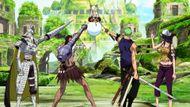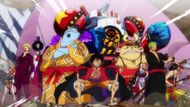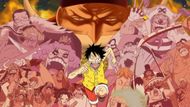The manga of One Piece started back in 1997, and to this date, it has become so popular that this series is competing against major Superhero titles. With over 578 million copies sold, One Piece is officially within striking distance of Superman’s 600 million, an astronomical feat considering Superman has had a 59-year head start.
It is important to note that Eiichiro Oda is the sole creator of One Piece and has managed to compete against these major Western giants. He has single-handedly created an immersive world and consistently released over 1155 chapters and counting.
In superhero comics, especially over the past few decades, there's been a trend of making characters suffer endlessly. From Gwen Stacy to Aunt May to MJ, Peter Parker’s life is one tragedy after another. Writers like Dan Slott, Joe Quesada, and Anne Nocenti have taken pride in putting characters through emotional grinders.

Meanwhile, this series doesn’t shy away from sadness either. Some of its most heartbreaking moments, Ace’s death, Robin’s childhood, and Nami’s past, are more devastating than anything in a typical superhero book. But here’s the difference: Oda balances tragedy with hope.
One of the biggest differences between superhero comics and One Piece is continuity. Western comics are notorious for rebooting every few years. New #1s, alternate timelines, multiverses, it’s dizzying.

Oda, on the other hand, has kept his series running with a singular, unbroken vision. There are no alternate Luffys. No rebooted timelines. Just one continuous story, building up its lore for over two decades.
He introduced over 1,500 characters, designed more than 100 Devil Fruits, and made sure that every island, every culture, and every laugh adds something to the bigger picture.
Additionally, no superhero comic can compete with One Piece’s worldbuilding. From Alabasta to Wano, every arc feels distinct, with its own history, culture, and political structure. There's no rinse-and-repeat formula. And while Batman may have Gotham, Luffy’s world is the entire sea, and it’s constantly expanding.
Even the power system, with Devil Fruits and Haki, evolves with time. Oda plays the long game, planting seeds for revelations 10 years in advance. Fans don’t just consume One Piece, they participate in it. They theorize, speculate, and debate. And Oda somehow always keeps a few curveballs up his sleeve.
What does One Piece becoming a global sensation mean for the industry

If you told someone in 2000 that One Piece would one day outsell Batman, they’d scoff. Say it’d beat Superman? Unthinkable. And yet, it’s happening. The sales are real. The fanbase is massive. The impact is undeniable.
The manga industry is changing the game, and Western comics would do well to pay attention. Maybe the future of comics isn’t in reboots, grimdark reimaginings, and broken status quos. Maybe it’s in stories that grow with their audience, that believe in redemption, friendship, and laughter.
A global empire built by one man

Superhero IPs are backed by massive corporations. They have dedicated teams for writing, marketing, merchandise, and film. One Piece? It’s Eiichiro Oda’s solo empire. From manga to anime, to getting the live-action Netflix adaptation (with a massive budget, by the way), it’s a global phenomenon, and it all started with one man.
Despite its initial lack of popularity outside Japan, this series is now an unstoppable franchise. And it's still ongoing. It has just entered the Final Saga, and fans can expect this to go on for at least a few more years.
And let’s not forget: the anime is getting a high-quality reboot, which promises to bring the story to a whole new generation of fans who might find the original pacing hard to keep up with.
How did Oda's magnum opus become so popular?

If I had to sum it up in one sentence, One Piece makes you feel good to be alive. That doesn’t mean it avoids heavy themes. Far from it. It touches on slavery, government corruption, genocide, loss, and grief. But it always circles back to the belief that life is worth fighting for.
Oda’s storytelling teaches us that you don’t need endless suffering to create conflict. You don’t need to traumatize your characters every arc to keep readers hooked. You can have light. You can have joy. And still tell a story that moves people to tears.
Final thoughts
One Piece cementing its place in the popularity chart against the superhero comics isn’t a knock on Western comics. They’ve given us some of the most iconic characters in pop culture. But One Piece has done something miraculous, without needing a team, a reboot, or a reset button. It started with a boy who wanted to be King of the Pirates. And in doing so, he became the King of Comics.
